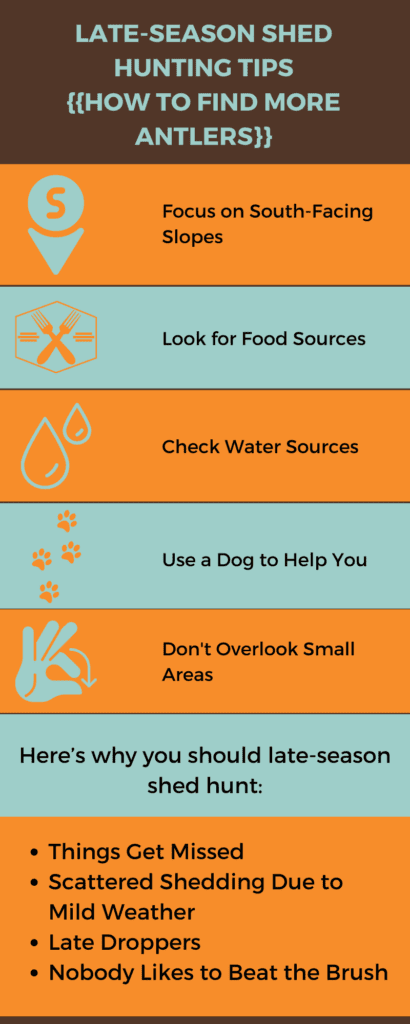Some people out there are die-hard shed hunters and seem to never stop. But, other people may shed hunt during “the drop” (while animals are dropping their antlers) and call it quits a week or two after everything is shed.
If you're an avid shed hunter, you know that the late season can be a challenging time to find antlers. However, with a few tips and tricks, you can increase your chances of success and make the most of your time in the field.
Here’s why you should late-season shed hunt:
Things Get Missed
Every year while shed hunting, I always pick up old sheds of all sizes. They range from a year old to who knows how old. That’s exactly why I try to shed hunt for as long as possible. There will always be missed antlers and missed winter kills, or areas that may have not gotten checked. This past season there have been a few “obvious” sheds that I would never have guessed would lay in an area for a year and never get picked up.
Scattered Shedding Due to Mild Weather
Here in Montana, sometimes we have fairly milder winters compared to other years. This results in scattered shedding because deer and elk can travel wherever they want instead of being restricted due to deep snow. There haven’t seemed to be any particular areas with heavy/concentrated shedding. Everything was scattered and there were many miles in between sheds. This discourages a lot of shed hunters and keeps them out of the field. Which leaves more sheds for you and me to pick up in July.

Late Droppers
There are always a few deer or elk that seem to hold on to their antlers forever. So, it makes you wonder – did they shed in an “obvious” area too late in the season for anybody to stumble on it? That’s a question I’m always asking myself. Maybe some of those late droppers dropped after everybody quit shed hunting those areas. Or, maybe their patterns changed as it got warmer. Maybe they dropped into a place they may not have been a year earlier. The possibilities are endless and pinpointing exactly where an animal is going to drop its antlers is almost impossible.
Nobody Likes to Beat the Brush
We all like to pick the low-hanging fruit first. And, some of us don’t want to beat any brush at all once we’ve reached that point. So it’s a great idea to go and beat some brush this time of year. Granted, there may be bears or ticks, but with proper precautions, these can be avoided.
I like to treat all my shed hunting attire with tick repellent this time of year. I will typically be noisy and I may even carry around a little speaker to play music attached to my bino harness to avoid surprising bears.
Here are some late-season shed hunting tips to help you find more antlers:
Focus on South-Facing Slopes
As the snow melts and the sun starts to warm up the ground, deer will begin to move to south-facing slopes to soak up the sun's rays. This makes these areas prime locations for shed hunting. Look for areas with good cover and food sources nearby, as deer will often bed down in these areas. Be sure to also check any nearby trails or travel corridors for dropped antlers.

Look for Food Sources
Late-season shed hunting can be tough. One way to increase your chances of finding antlers is to focus on areas with food sources. Deer will often drop their antlers while feeding, so look for areas with fresh browse or food plots. Pay attention to any tracks or droppings in the area, as this can indicate recent deer activity. Additionally, if you know of any fruit trees or nut-bearing trees in the area, be sure to check around them as well.
Check Water Sources
Another great tip for late-season shed hunting is to check water sources. Deer need water to survive, so they will often visit streams, ponds, or other bodies of water to drink. Look for areas where deer may have crossed the water, such as shallow areas or banks with muddy footprints. You may also want to check areas where water is scarce, as deer may be more likely to drop their antlers while drinking from a small puddle or stream. By focusing on water sources, you can increase your chances of finding antlers and make the most of your time in the field.
Use a Dog to Help You
One of the best ways to increase your chances of finding shed antlers is to use a trained dog to help you. Dogs have a keen sense of smell and can easily pick up the scent of antlers that have been dropped by deer. There are many breeds of dogs that are well-suited for shed hunting, including Labrador Retrievers, German Shorthaired Pointers, and Bloodhounds. With a dog by your side, you'll be able to cover more ground and find more antlers than you would on your own.
Don't Overlook Small Areas
When it comes to shed hunting, it's easy to focus on large open areas and overlook smaller, more secluded spots. However, deer often drop their antlers in areas where they feel safe and secure, such as thick brush or under trees. Be sure to thoroughly search these smaller areas, using a grid pattern to ensure you don't miss anything. You may be surprised at the number of antlers you find in these overlooked spots.



